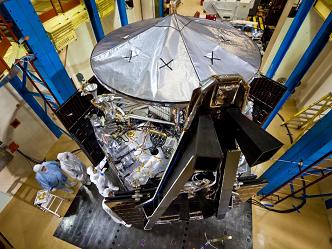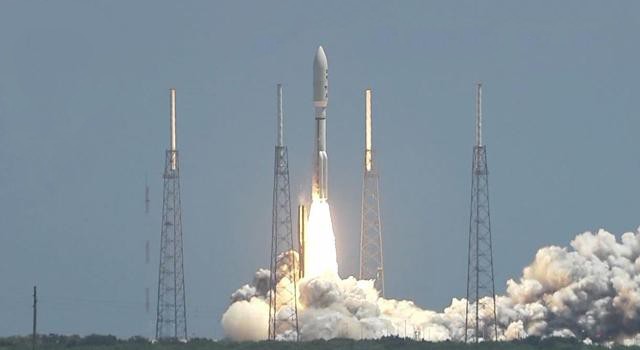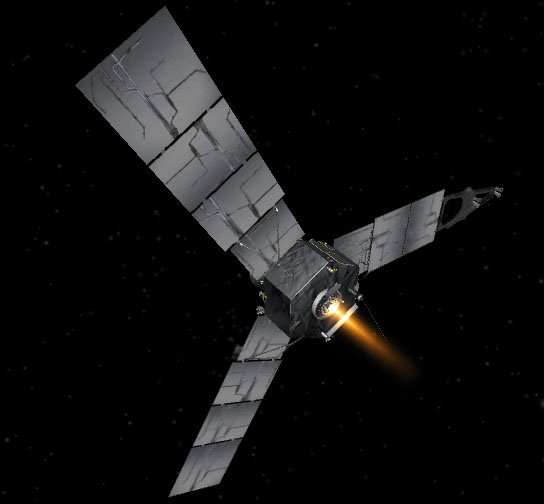Juno zal 37 banen om Jupiter maken. Daarna wordt hij de atmosfeer van Jupiter ingestuurd...wat zijn einde betekent.
NASA's Juno Spacecraft Getting Close to Jupiter

Credits: NASA/JPL-Caltech
NASA's Juno mission, launched nearly five years ago, will soon reach its final destination: the most massive planet in our solar system, Jupiter. On the evening of July 4, at roughly 9 p.m. PDT (12 a.m. EDT, July 5), the spacecraft will complete a burn of its main engine, placing it in orbit around the king of planets.
During Juno's orbit-insertion phase, or JOI, the spacecraft will perform a series of steps in preparation for a main engine burn that will guide it into orbit. At 6:16 p.m. PDT (9:16 p.m. EDT), Juno will begin to turn slowly away from the sun and toward its orbit-insertion attitude. Then 72 minutes later, it will make a faster turn into the orbit-insertion attitude.
At 7:41 p.m. PDT (10:41 p.m. EDT), Juno switches to its low-gain antenna. Fine-tune adjustments are then made to the spacecraft's attitude. Twenty-two minutes before the main engine burn, at 7:56 p.m. PDT (10:56 p.m. EDT), the spacecraft spins up from 2 to 5 revolutions per minute (RPM) to help stabilize it for the orbit insertion burn.
At 8:18 p.m. PDT (11:18 p.m. EDT), Juno's 35-minute main-engine burn will begin. This will slow it enough to be captured by the giant planet’s gravity. The burn will impart a mean change in velocity of 1,212 mph (542 meters a second) on the spacecraft. It is performed in view of Earth, allowing its progress to be monitored by the mission teams at NASA's Jet Propulsion Laboratory in Pasadena, California, and Lockheed Martin Space Systems in Denver, via signal reception by Deep Space Network antennas in Goldstone, California, and Canberra, Australia.
After the main engine burn, Juno will be in orbit around Jupiter. The spacecraft will spin down from 5 to 2 RPM, turn back toward the sun, and ultimately transmit telemetry via its high-gain antenna.
Juno starts its tour of Jupiter in a 53.5-day orbit. The spacecraft saves fuel by executing a burn that places it in a capture orbit with a 53.5-day orbit instead of going directly for the 14-day orbit that will occur during the mission's primary science collection period. The 14-day science orbit phase will begin after the final burn of the mission for Juno’s main engine on October 19.
JPL manages the Juno mission for NASA. The mission's principal investigator is Scott Bolton of Southwest Research Institute in San Antonio. The mission is part of NASA's New Frontiers Program, managed at the agency's Marshall Space Flight Center in Huntsville, Alabama, for NASA's Science Mission Directorate. Lockheed Martin Space Systems in Denver built the spacecraft.
Learn more about the June mission, and get an up-to-date schedule of events, at:
http://www.nasa.gov/juno
https://solarsystem.nasa.gov/planets/jupiter/junotoolkit
Bron: http://www.nasa.gov/feature/nasas-juno-spacecraft-getting-close-to-jupiter
Enkele weetjes......
Juno is op 5 augustus 2011 gelanceerd vanaf Cape Canaveral Air Force Station in Florida om vijf voor half zeven Nederlandse tijd. In juli 2016 en bijna 3 miljard kilometer verder komt de satelliet bij Jupiter aan.
De Juno-missie kost de NASA ongeveer 1,1 miljard dollar.

Juno klaar voor vertrek photo NASA

De missieleiders schreeuwden Go, Juno! bij de lancering Photo NASA
Het ruimtevaartuig werkt op zonne-energie en zal in een baan draaien die ongeveer 4500 kilometer boven de wolkentoppen van Jupiter ligt.
Het ruimtevaartuig Juno moet gedurende meer dan een jaar het inwendige van de planeet gaan bestuderen, door het zwaartekrachtsveld heel nauwkeurig te onderzoeken en in kaart te brengen. Aan het eind van de missie zal een gecontroleerde landing (verbranding) volgen in de dichte wolkenmassa van Jupiter.

Photo NASA
Ook de rotsachtige binnenkern wordt onderzocht en of er water in de atmosfeer aanwezig is. Daarnaast wordt de windsnelheid gemeten, die een snelheid van 600 kilometer per uur kan bereiken.
In 2012 heeft de Juno twee koerscorrecties gekregen, in 2013 ook nog één. Deze koerscorrecties waren nodig om ervoor te zorgen dat Juno de juiste koers en snelheid had voor zijn scheervlucht langs de aarde, op 9 oktober 2013.
Deze route langs de aarde was nodig om Juno daarna met een snelheid van ruim zeven kilometer per seconde in de richting van Jupiter te sturen, zonder dat dit veel brandstof kost. De koerscorrectie verbruikte in een half uur 376 kilogram brandstof om een snelheidsverandering van 344 meter per seconde te krijgen. De aankomst van Juno bij Jupiter staat gepland op 4 juli 2016.
De Romeinse god Jupiter, zijn vrouw Juno en Galileo Galilei (ontdekker van de vier grootste Jupitermanen) bevinden zich als LEGO-poppetjes (2,5 centimeter groot) aan boord van de Juno.
Bron: http://www.reuzenplaneten.nl/jupiter/juno.html
Live te volgen:
Monday, July 4 – Orbit Insertion DayNoon -- Pre-orbit insertion briefing at JPL
10:30 p.m. -- Orbit insertion and NASA TV commentary begin
Tuesday, July 5
1 a.m. -- Post-orbit insertion briefing at JPL
To watch all of these events online, visit:
http://www.nasa.gov/nasatv
http://www.ustream.tv/nasa
http://www.ustream.tv/nasajpl2
Live coverage on orbit insertion day also will be available online via Facebook Live at:
http://www.facebook.com/nasa
http://www.facebook.com/nasajpl
| Gewijzigd: 1 februari 2017, 10:14 uur, door Joyce.s
Daar is hij dan, de 1e foto van Juno
NASA’s Juno Spacecraft Sends First In-orbit View

This color view from NASA's Juno spacecraft is made from some of the first images taken by JunoCam after the spacecraft entered orbit around Jupiter on July 5th (UTC).
Credits: NASA/JPL-Caltech/SwRI/MSSS
The JunoCam camera aboard NASA's Juno mission is operational and sending down data after the spacecraft’s July 4 arrival at Jupiter. Juno’s visible-light camera was turned on six days after Juno fired its main engine and placed itself into orbit around the largest planetary inhabitant of our solar system. The first high-resolution images of the gas giant Jupiter are still a few weeks away.
"This scene from JunoCam indicates it survived its first pass through Jupiter's extreme radiation environment without any degradation and is ready to take on Jupiter," said Scott Bolton, principal investigator from the Southwest Research Institute in San Antonio. "We can't wait to see the first view of Jupiter's poles."
The new view was obtained on July 10, 2016, at 10:30 a.m. PDT (1:30 p.m. EDT, 5:30 UTC), when the spacecraft was 2.7 million miles (4.3 million kilometers) from Jupiter on the outbound leg of its initial 53.5-day capture orbit. The color image shows atmospheric features on Jupiter, including the famous Great Red Spot, and three of the massive planet's four largest moons -- Io, Europa and Ganymede, from left to right in the image.
"JunoCam will continue to take images as we go around in this first orbit," said Candy Hansen, Juno co-investigator from the Planetary Science Institute, Tucson, Arizona. "The first high-resolution images of the planet will be taken on August 27 when Juno makes its next close pass to Jupiter."
JunoCam is a color, visible-light camera designed to capture remarkable pictures of Jupiter's poles and cloud tops. As Juno's eyes, it will provide a wide view, helping to provide context for the spacecraft's other instruments. JunoCam was included on the spacecraft specifically for purposes of public engagement; although its images will be helpful to the science team, it is not considered one of the mission's science instruments.
The Juno team is currently working to place all images taken by JunoCam on the mission's website, where the public can access them.
During its mission of exploration, Juno will circle the Jovian world 37 times, soaring low over the planet's cloud tops -- as close as about 2,600 miles (4,100 kilometers). During these flybys, Juno will probe beneath the obscuring cloud cover of Jupiter and study its auroras to learn more about the planet's origins, structure, atmosphere and magnetosphere.
JPL manages the Juno mission for the principal investigator, Scott Bolton, of Southwest Research Institute in San Antonio. Juno is part of NASA's New Frontiers Program, which is managed at NASA's Marshall Space Flight Center in Huntsville, Alabama, for NASA's Science Mission Directorate. Michael Ravine of Malin Space Science Systems, San Diego, is the JunoCam instrument lead. Lockheed Martin Space Systems, Denver, built the spacecraft. Caltech in Pasadena manages JPL for NASA.
To see a full video of Jupiter and the Galilean moons during Juno's approach to Jupiter, visit:
Bron: http://www.nasa.gov/feature/jpl/nasa-s-juno-spacecraft-sends-first-in-orbit-view

 Jupiter en Juno
Jupiter en Juno




